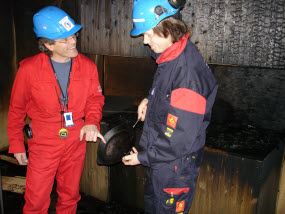
|
This is how a kitchen may look after a fire, if you have no automatic fire fighting devices. SINTEF researchers Geir Drangsholt (left) and Bjørn Egil Rossebø walk around in a burnt-out kitchen after fire trials at SINTEF NBL. Photo: Svein Tønseth |
Water-mist is a relatively new method for fire fighting, which so far has been most widely used in industry and on board ships and oil platforms. The water mist damps down the fire and lowers the temperature at the site of the fire. This can be vital for the successful evacuation and rescue of fire victims.
Two fire reducing effects
The method consists of supplying a shower of microscopic water droplets, which turn to steam when they meet the fire. This reduces the fire in two different ways: the evaporation process steals heat from the flames and cools them down, while the dramatic increase in the volume of the mist when the water turns to steam displaces the oxygen needed by the combustion process.
Portable apparatus
Until now, water misting has been used in fixed systems, in which the pipework and nozzles are part of the building structure. In the course of the past few weeks SINTEF has been testing portable systems that can either be built into existing furnishings or designed as a freestanding unit in a room. The tests will show whether portable water mist systems are as effective in a domestic setting as fixed sprinkler systems.
People living alone and in sheltered housing units
The aim is to develop a device that can be installed in the apartments of elderly people when they are no longer so quick on their feet. When younger tenants take over the apartment, the system can be moved out again.
This could also be a solution for sheltered housing run by local authorities. Portable systems would cause much less disruption in a house than installing fixed pipework under the ceiling.
Not there yet
The Norwegian Directorate for Civil Protection and Emergency Planning took the initiative to launch the SINTEF project, which it is also financing. Until now, portable systems have not been available on the market, so SINTEF approached equipment manufacturers and asked them to produce prototype versions that could be tested in the laboratory.
SINTEF Fire researcher Geir Drangsholt says that SINTEF received systems from five suppliers. “None of them could be used just as they are today, but some of them only need minor modifications. Our tests have shown which aspects the manufacturers need to alter. We are sure that it should be possible with a bit more development to produce solutions that are capable of cooling down fires efficiently”, says Drangsholt.
Toxic gases
Drangsholt points out that one of the most important aims of the project is to find out just how much a portable water mist system could reduce the production of toxic gases during a fire.
“We believe that a water mist system will make it easier to get elderly people out of a burning room, but we still need to identify the effects of water mists on toxic gases”, he says.
Contact:
By Svein Tønseth
